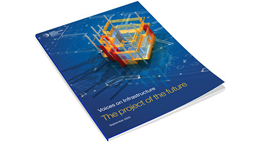The construction industry and its supporting ecosystem have shown unsatisfactory performance in recent years, and external market factors and complex industry dynamics have impeded attempts at change. Over the next decade, however, new technologies and increased product digitization are likely to disrupt parts of the construction ecosystem, transforming the industry as we know it.
Two-thirds of the industry executives we recently surveyed agree that the COVID-19 pandemic has accelerated this transformation; half report that they have already raised their level of digitization investment. Moreover, our research shows that a significant share of the $11 trillion global value added and $1.5 trillion of global profit pools could be redistributed along the value chain—a staggering 40 to 45 percent in the most affected segments. Executives must therefore consider not only the project of the future, but also the product of the future, developed along the value chain and the ecosystem of the future.
In other words, industry dynamics will shift from a fragmented construction process to one that is more standardized, consolidated, and integrated. Those players that move faster and smarter than their competitors can increase their own profitability many times over. As an example of how the industry’s total value could be reshuffled, we will examine the materials distribution and logistics segment.
Industry disruption’s effects on the value chain
In late 2019, we conducted a global survey of 400 industry decision makers—primarily executives, owners, and principals—and asked them which factors they believe will affect the industry. The results suggest unprecedented disruption, especially regarding new production technology and the digitization of products (exhibit).

All players across the value chain will need to develop their strategies for dealing with disruption. This includes financing and development; the supply of materials, components, and machinery; off-site construction; and on-site construction and assembly. But it is especially true for materials distribution and logistics, engineering and planning, and general and specialized contracting—all of which survey respondents say will experience the largest disruption.
Would you like to learn more about our Capital Projects & Infrastructure Practice?
A closer look at materials distribution
Materials-distribution companies procure basic materials, components, and equipment and then resell them to consumers and businesses.
Today, the segment represents a high share of both value added (8 to 12 percent) and profits (13 to 17 percent) in the construction ecosystem. These figures come as no surprise, since distributors connect suppliers with project sites and subcontractors, keep stock of a complex array of components and materials, handle logistics, and even provide credit in some regions.
However, many survey respondents believe that distributors could see value erode if no action is taken to overhaul their current business models, particularly in the new-build segment:
- Greater standardization and productization, such as better planning with building-information modeling (BIM), could move decisions upstream to less-fragmented and more-sophisticated buyers, and reduce the scope of materials needed.
- Digital twins and building-management systems (BMS) could make it possible to plan for and predict repair and maintenance needs, thus reducing the need for local stock.
- Better on-site efficiency could increase the need for just-in-time logistics.
- Expanded online marketplaces for materials and direct sales from suppliers could increase price transparency versus performance, likely resulting in a reduction in the breadth of materials on the market and creating a new set of competitors—while also potentially increasing direct-to-site deliveries, undermining the economics of a store network.
- Increased off-site construction could shift procurement to factories with consolidated demand and relatively predictable planning horizons, reducing the need for store networks.
As a result, the value distributors add (and their profit pools) might materially decline in coming years, in a challenge that may not be as severe as the ones facing players such as contractors and designers, but which may still be notable. In fact, 20 percent of survey respondents believe that materials distributors will see the largest decline—or even stop existing in their current form—within ten years.
Yet another outcome is possible as well: distributors could reposition themselves as industrial-grade logistics hubs for the construction setup of the future. In this scenario, distributors become even more effective as catalysts for productivity at sites, generating substantial value for the entire industry by cutting time and effort now wasted in searching for, waiting for, and moving materials on-site.

Voices on Infrastructure: The project of the future
What construction industry leaders can do now
All companies, regardless of where they are situated along the value chain, have a choice: either defend the core and transform to adjust to the changing environment, or actively reinvent themselves to attack and disrupt the markets they operate in. These disruptive plays require investing and risk taking, but successful moves could be rewarded with step changes in profitability and valuation.
The leaders will likely be those that gain scale and consolidate the market while excelling at demand forecasting and inventory planning, as well as lean efficiencies and category reviews. These capabilities will be crucial to fulfilling increased demand for flexible, just-in-time, value-added logistics to construction sites and prefabrication plants, and to providing on-site logistics planning and operations. Digital interfaces are becoming increasingly essential as well, connecting with BIM and BMS for optimal planning and ordering, and offering advice through digitized expertise. Simpler preassembly, submodules, and kitting for the customer will save time on-site.
Companies will also be expected to meet customers’ sustainability expectations on logistics emissions, design labeling that transparently communicates the sustainability impact of alternative building materials, and offer guidance in the selection of optimal materials.
Distributors could reinvent themselves by taking on a role as the future construction landscape’s logistics hub. In doing so, they could create new value for customers, for instance, by helping with international sourcing or offering credit finance, packing in assembly order, in-room delivery, delivery before the working day, providing on-site logistics planning, and operations, or even offering simple preassembly.
As disruption creates a new “ecosystem of the future,” all players in the value chain will need to reposition or reinvent themselves. While looming disruption may seem daunting, those companies who successfully take the lead stand to gain market share and raise profitability.


